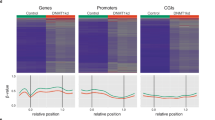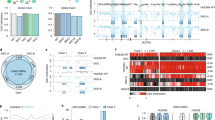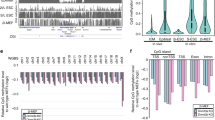Abstract
Cytosine methylation of mammalian DNA is essential for the proper epigenetic regulation of gene expression and maintenance of genomic integrity. To define the mechanism through which demethylated cells die, and to establish a paradigm for identifying genes regulated by DNA methylation, we have generated mice with a conditional allele for the maintenance DNA methyltransferase gene Dnmt1. Cre-mediated deletion of Dnmt1 causes demethylation of cultured fibroblasts and a uniform p53-dependent cell death. Mutational inactivation of Trp53 partially rescues the demethylated fibroblasts for up to five population doublings in culture. Oligonucleotide microarray analysis showed that up to 10% of genes are aberrantly expressed in demethylated fibroblasts. Our results demonstrate that loss of Dnmt1 causes cell-type–specific changes in gene expression that impinge on several pathways, including expression of imprinted genes, cell-cycle control, growth factor/receptor signal transduction and mobilization of retroelements.
This is a preview of subscription content, access via your institution
Access options
Subscribe to this journal
Receive 12 print issues and online access
$209.00 per year
only $17.42 per issue
Buy this article
- Purchase on Springer Link
- Instant access to full article PDF
Prices may be subject to local taxes which are calculated during checkout







Similar content being viewed by others
References
Wolffe, A.P. & Matzke, M.A. Epigenetics: regulation through repression. Science 286, 481– 486 (1999).
Bird, A.P. & Wolffe, A.P. Methylation-induced repression—belts, braces, and chromatin. Cell 99, 451– 454 (1999).
Jaenisch, R. DNA methylation and imprinting: why bother? Trends Genet. 13, 323–329 (1997).
Lei, H. et al. De novo DNA cytosine methyltransferase activities in mouse embryonic stem cells. Development 122, 3195– 3205 (1996).
Li, E., Bestor, T.H. & Jaenisch, R. Targeted mutation of the DNA methyltransferase gene results in embryonic lethality. Cell 69, 915–926 (1992).
Okano, M., Bell, D.W., Haber, D.A. & Li, E. DNA methyltransferases Dnmt3a and Dnmt3b are essential for de novo methylation and mammalian development . Cell 99, 247–257 (1999).
Li, E., Beard, C. & Jaenisch, R. Role for DNA methylation in genomic imprinting. Nature 366, 362–365 ( 1993).
Beard, C., Li, E. & Jaenisch, R. Loss of methylation activates Xist in somatic but not in embryonic cells. Genes Dev. 9, 2325– 2334 (1995).
Panning, B. & Jaenisch, R. DNA hypomethylation can activate Xist expression and silence X-linked genes. Genes Dev. 10, 1991–2002 (1996).
Stancheva, I. & Meehan, R.R. Transient depletion of xDnmt1 leads to premature gene activation in Xenopus embryos. Genes Dev. 14, 313–327 (2000).
Baylin, S.B. & Herman, J.G. DNA hypermethylation in tumorigenesis: epigenetics joins genetics. Trends Genet. 16, 168–174 (2000).
Jones, P.A. & Laird, P.W. Cancer epigenetics comes of age . Nature Genet. 21, 163– 167 (1999).
Laird, P.W. et al. Suppression of intestinal neoplasia by DNA hypomethylation . Cell 81, 197–205 (1995).
Chen, R.Z., Pettersson, U., Beard, C., Jackson-Grusby, L. & Jaenisch, R. DNA hypomethylation leads to elevated mutation rates. Nature 395, 89– 93 (1998).
Hansen, R.S. et al. The DNMT3B DNA methyltransferase gene is mutated in the ICF immunodeficiency syndrome. Proc. Natl. Acad. Sci. USA 96, 14412–14417 (1999).
Xu, G.L. et al. Chromosome instability and immunodeficiency syndrome caused by mutations in a DNA methyltransferase gene. Nature 402 , 187–191 (1999).
Sauer, B. & Henderson, N. Site-specific DNA recombination in mammalian cells by the Cre recombinase of bacteriophage P1. Proc. Natl. Acad. Sci. USA 85, 5166– 5170 (1988).
Margot, J.B. et al. Structure and function of the mouse DNA methyltransferase gene: Dnmt1 shows a tripartite structure. J. Mol. Biol. 297, 293–300 (2000).
Onishi, M. et al. Applications of retrovirus-mediated expression cloning. Exp. Hematol. 24, 324–329 (1996).
Levine, A.J. p53, the cellular gatekeeper for growth and division. Cell 88, 323–331 (1997).
Hakem, R., de la Pompa, J.L., Elia, A., Potter, J. & Mak, T.W. Partial rescue of Brca1 (5-6) early embryonic lethality by p53 or p21 null mutation. Nature Genet. 16, 298–302 ( 1997).
Lim, D.S. & Hasty, P. A mutation in mouse rad51 results in an early embryonic lethal that is suppressed by a mutation in p53. Mol. Cell. Biol. 16, 7133–7143 (1996).
Ludwig, T., Chapman, D.L., Papaioannou, V.E. & Efstratiadis, A. Targeted mutations of breast cancer susceptibility gene homologs in mice: lethal phenotypes of Brca1, Brca2, Brca1/Brca2, Brca1/p53, and Brca2/p53 nullizygous embryos. Genes Dev. 11, 1226– 1241 (1997).
Jacks, T. et al. Tumor spectrum analysis in p53-mutant mice. Curr. Biol. 4, 1–7 ( 1994).
Emerman, M. & Temin, H.M. Genes with promoters in retrovirus vectors can be independently suppressed by an epigenetic mechanism. Cell 39, 449–467 ( 1984).
Leonhardt, H., Page, A.W., Weier, H.U. & Bestor, T.H. A targeting sequence directs DNA methyltransferase to sites of DNA replication in mammalian nuclei . Cell 71, 865–873 (1992).
Chuang, L.S. et al. Human DNA-(cytosine-5) methyltransferase-PCNA complex as a target for p21WAF1. Science 277, 1996– 2000 (1997).
Fambrough, D., McClure, K., Kazlauskas, A. & Lander, E.S. Diverse signaling pathways activated by growth factor receptors induce broadly overlapping, rather than independent, sets of genes. Cell 97, 727–741 (1999).
Bird, A. & Tweedie, S. Transcriptional noise and the evolution of gene number. Philos. Trans. R. Soc. Lond. B. Biol. Sci. 349, 249–253 (1995).
Yoder, J.A., Walsh, C.P. & Bestor, T.H. Cytosine methylation and the ecology of intragenomic parasites. Trends Genet. 13, 335– 340 (1997).
Fan, G.P. et al. DNA hypomethyation perturbs the function and survival of CNS neurons in postnatal animals. J. Neurosci. (in press).
Sabapathy, K., Klemm, M., Jaenisch, R. & Wagner, E.F. Regulation of ES cell differentiation by functional and conformational modulation of p53 . EMBO J. 16, 6217–6229 (1997).
Hermeking, H. & Eick, D. Mediation of c-Myc-induced apoptosis by p53. Science 265, 2091– 2093 (1994).
Hendrich, B. & Bird, A. Identification and characterization of a family of mammalian methyl-CpG binding proteins. Mol. Cell. Biol. 18, 6538–6547 ( 1998).
Michaelson, J.S., Bader, D., Kuo, F., Kozak, C. & Leder, P. Loss of Daxx, a promiscuously interacting protein, results in extensive apoptosis in early mouse development. Genes Dev. 13, 1918–1923 (1999).
Walsh, C.P., Chaillet, J.R. & Bestor, T.H. Transcription of IAP endogenous retroviruses is constrained by cytosine methylation. Nature Genet. 20, 116–117 (1998).
Marahrens, Y., Panning, B., Dausman, J., Strauss, W. & Jaenisch, R. Xist-deficient mice are defective in dosage compensation but not spermatogenesis. Genes Dev. 11, 156–166 (1997).
Cormier, R.T. & Dove, W.F. Dnmt1N/+ reduces the net growth rate and multiplicity of intestinal adenomas in C57BL/6-multiple intestinal neoplasia (Min)/+ mice independently of p53 but demonstrates strong synergy with the modifier of Min 1(AKR) resistance allele. Cancer Res. 60, 3965–3970 (2000).
Rhee, I. et al. CpG methylation is maintained in human cancer cells lacking DNMT1 . Nature 404, 1003–1007 (2000).
Knox, J.D. et al. Inhibition of DNA methyltransferase inhibits DNA replication . J. Biol. Chem. 275, 17986– 17990 (2000).
Fuks, F., Burgers, W.A., Brehm, A., Hughes-Davies, L. & Kouzarides, T. DNA methyltransferase Dnmt1 associates with histone deacetylase activity. Nature Genet. 24, 88–91 (2000).
Robertson, K.D. et al. DNMT1 forms a complex with rb, E2F1 and HDAC1 and represses transcription from E2F-responsive promoters. Nature Genet. 25, 338–342 (2000).
Rountree, M.R., Bachman, K.E. & Baylin, S.B. DNMT1 binds HDAC2 and a new co-repressor, DMAP1, to form a complex at replication foci. Nature Genet. 25 , 269–277 (2000).
Bird, A. Does DNA methylation control transposition of selfish elements in the germline? Trends Genet. 13, p469– 472 (1997).
Yoder, J.A., Walsh, C.P. & Bestor, T.H. Cytosine methylation and the ecology of intragenomic parasites. Trends Genet. 13, 335– 340 (1997).
Walsh, C.P. & Bestor, T.H. Cytosine methylation and mammalian development. Genes Dev. 13, 26– 34 (1999).
Colosi, P., Talamantes, F. & Linzer, D.I. Molecular cloning and expression of mouse placental lactogen I complementary deoxyribonucleic acid. Mol. Endocrinol. 1, 767–776 ( 1987).
Ruggiu, M. et al. The mouse Dazla gene encodes a cytoplasmic protein essential for gametogenesis. Nature 389, 73– 77 (1997).
Jat, P.S., Cepko, C.L., Mulligan, R.C. & Sharp, P.A. Recombinant retroviruses encoding simian virus 40 large T antigen and polyomavirus large and middle T antigens. Mol. Cell. Biol. 6, 1204–1217 (1986).
O'Gorman, S., Dagenais, N.A., Qian, M. & Marchuk, Y. Protamine-Cre recombinase transgenes efficiently recombine target sequences in the male germ line of mice, but not in embryonic stem cells. Proc. Natl. Acad. Sci. USA 94, 14602–14607 (1997).
Church, G.M. & Gilbert, W. Genomic sequencing. Proc. Natl. Acad. Sci. USA 81, 1991– 1995 (1984).
Eisen, M.B., Spellman, P.T., Brown, P.O. & Botstein, D. Cluster analysis and display of genome-wide expression patterns. Proc. Natl. Acad. Sci. USA 95, 14863– 14868 (1998).
Gaudet, F., Talbot, D., Leonhardt, H. & Jaenisch, R. A short DNA methyltransferase isoform restores methylation in vivo. J. Biol. Chem. 273, 32725–32729 (1998).
Acknowledgements
We thank T. Golub for discussion regarding the Affymetrix GeneCHIP array experiments; M. Gaasenbeek, C. Heard, K. McClure and J. Park for training and technical assistance with GeneCHIP scanning; U. Petersson for help with pilot experiments using adenovirus to transduce Cre into the Dnmt12lox cultures; E. Koh and S. Cherry for advice on retroviral infections; B. Sauer for the loxP cassette pBS246; S. O'Gorman for the cre vector pOG231; J. Bogan for pMXpuro and pMXgfp; E. Koh for Phoenix cells; A. Fazeli and R. Weinberg for the p53 mutant mice; and T. Bestor for the IAP probe. L.J.G. was supported by the NIH and Pfizer. Funding for this work was through NIH grants R-35-CA44339 (R.J.) and HD18184 (C.W.), the March of Dimes (C.W.), and grants from Affymetrix Inc., Millenium Pharmaceuticals Inc., and Bristol-Meyers Squibb Company.
Author information
Authors and Affiliations
Corresponding author
Rights and permissions
About this article
Cite this article
Jackson-Grusby, L., Beard, C., Possemato, R. et al. Loss of genomic methylation causes p53-dependent apoptosis and epigenetic deregulation. Nat Genet 27, 31–39 (2001). https://doi.org/10.1038/83730
Received:
Accepted:
Issue Date:
DOI: https://doi.org/10.1038/83730
This article is cited by
-
Auto-suppression of Tet dioxygenases protects the mouse oocyte genome from oxidative demethylation
Nature Structural & Molecular Biology (2024)
-
Proceedings of the inaugural Dark Genome Symposium: November 2022
Mobile DNA (2023)
-
Base editing-mediated one-step inactivation of the Dnmt gene family reveals critical roles of DNA methylation during mouse gastrulation
Nature Communications (2023)
-
Priming a vascular-selective cytokine response permits CD8+ T-cell entry into tumors
Nature Communications (2023)
-
High-resolution Nanopore methylome-maps reveal random hyper-methylation at CpG-poor regions as driver of chemoresistance in leukemias
Communications Biology (2023)



